It's that time of year again, when equestrians and socialites' thoughts turn to Bridgehampton and the grounds of the Hampton Classic, which will be held there this year from Aug. 27 to Sept. 3.
As if the annual horse show and competition wasn't enough proof of an absolute mania for horses and riding on the South Fork, a new coffee-table book confirms that there is more to be said and shown on the subject. Blue Carreon's "Equestrian Life in the Hamptons" is chock full of illustrations of "the current breed of leisure and competitive riders, some of Olympic caliber," along with polo players and other enthusiasts.
Almost as soon as there was a summer colony on the South Fork, there were horses. As they graduated from farm stock to the sporting life here, a culture was born.
Evidence of this early engagement with horses comes from the Southampton Horse Show, which, according to a history of the Hampton Classic on its website, began in the early 20th century in fields overlooking Lake Agawam in that village. World War I put an end to it, but it was revived in the 1920s, when the Southampton Riding and Hunt Club was established. In 1928, the club completed construction on its headquarters and grounds. It then began hosting the horse show on some 30 acres off Majors Path in North Sea.
Classic images taken there of Jacqueline Bouvier as a child in the 1930s with her mother offer further documentation of this tradition, until the club was disbanded and sold after World War II broke out.
A horse show of some kind continued through the 20th century with a few pauses, but always a revival. Taking a leap to more recent years, the Southampton show was again revived, in 1971 at the Topping Riding Club in Sagaponack to benefit the then-Hampton Day School. During this time the shows became known as much for their sporting as social aspects as they became more competitive.
By 1976, the show was expanded to a five-day one with show jumping and some of the top-rated riders and horses of the time at Dune Alpin Farm in East Hampton. A hurricane damaged the grounds that year, but not the determination of the workers and volunteers who came together to salvage the show.
The next year, the Hampton Classic was incorporated, offering a $10,000 purse for its grand prix competition. It moved to its present location in 1982. The 65-acre grounds on Snake Hollow Road have been upgraded over the years to include tents and grandstands and other amenities such as boutiques and food concessions. In 2020, because of the pandemic, one more pause occurred -- the first since 1976 -- but the weeklong contest was back in 2021.
In addition to this premier and professional event, polo tournaments still are held on private grounds. There are also the quotidian lives of the hobbyist horsemen with horses stabled on their property or in group quarters dotted throughout the South Fork.
This is how Mr. Carreon paints the picture aside from the photographs he includes in his book: "Horses graze on paddocks with shingle-style mansions lined with hedges and hydrangeas in the background. Local riders compete for ribbons, then celebrate their victories with bonfires on the beach."
His book has chapters devoted to the history of horses and riding on the South Fork and images that are a mash-up of actual competitions with family portraits of riders such as Joey Wolffer and her children, tours of barns, and mannered, fashion-style shoots of moody and pouty riders in gear, regular dress, or evening wear atop or next to their horses. Mr. Carreon himself is featured seated at a rustic yet sophisticatedly set table in a field with an equine friend joining him.
He has interviewed a number of devotees, from the wealthiest summer residents to those who have made a career in the field. The former fashion editor has an eye for striking images, and there are hundreds of them in the book. He is also an avid equestrian, dividing his time among East Hampton, Manhattan, and Palm Beach.





